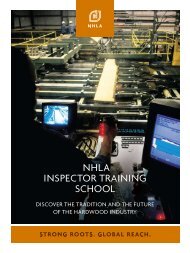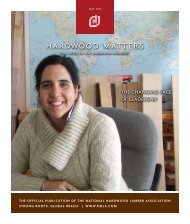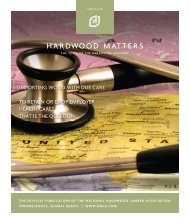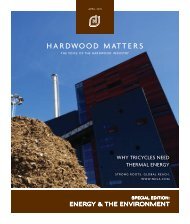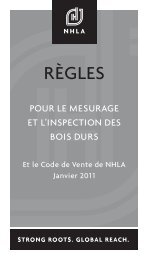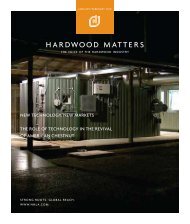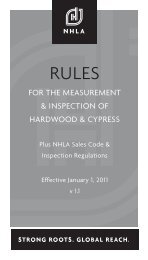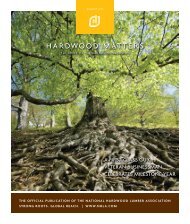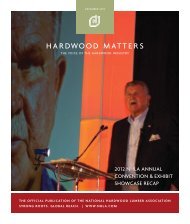hm - June11 - cover.indd - National Hardwood Lumber Association
hm - June11 - cover.indd - National Hardwood Lumber Association
hm - June11 - cover.indd - National Hardwood Lumber Association
- No tags were found...
You also want an ePaper? Increase the reach of your titles
YUMPU automatically turns print PDFs into web optimized ePapers that Google loves.
RULES<br />
CORNER<br />
WALNUT STEAMING<br />
By Dana Spessert, NHLA Chief Inspector<br />
One of the most interesting things I have noticed since becoming<br />
Chief Inspector, is at times there seems to be some areas of the rules<br />
that are not <strong>cover</strong>ed extensively enough in the NHLA Rules Book.<br />
One such area is the walnut grades, specifically in regards to the<br />
steaming process. The reason that I bring this up is because I recently<br />
received questions about the quality of the steaming process of some<br />
walnut shipments. I would like to make it clear that NHLA does not<br />
have any official rule regarding the quality of the steaming process.<br />
The quality of the steaming process has always been monitored by the<br />
industry and varies from facility to facility.<br />
In the following words I would like to clarify the walnut rules as it<br />
pertains to the sapwood limitations in the various grades. The first<br />
sentence under the “Walnut and Butternut” section of the 2011<br />
Rules Book states:<br />
“When Walnut has been steamed and is sold and specified as<br />
‘Steamed Walnut’, sapwood shall not be considered.”<br />
That statement pertains to the sapwood limitations of the area of<br />
the faces for which they are allowed when the walnut has not been<br />
specified as ‘Steamed Walnut’. Defects that show up in the area of the<br />
sapwood or heartwood should always be considered when grading<br />
walnut regardless of whether it is steamed or not.<br />
CUP ALLOWANCE<br />
Another question I recently received was in regard to the amount of cup that is<br />
allowed in a board. The answer is very simple, although the way to measure for it<br />
may not be. The amount of cup is defined in paragraph 29 “Cutting” which states:<br />
“A portion of a board or plank obtained by crosscutting or ripping, or by both. In<br />
the Common grades, a cutting shall be flat enough to surface two sides to standard<br />
surfaced thickness after it has been removed from the board. In the grades of Selects<br />
and Better the entire board must be flat enough to surface two sides to standard<br />
surfaced thickness (for skip limitations, see page 50 under the rule “Clear-Face”<br />
Cutting Grade). Diagonal cuttings are not permitted.”<br />
In order to determine the amount of cup that would be allowed can be very difficult<br />
to measure in the common grades as the Cuttings themselves only need to be flat<br />
enough to S2S to standard surfaced thickness. In my experience, most facilities<br />
surface their lumber prior to the ripping or crosscutting in order to make the in-feed<br />
process more efficient. The problem with this setup is that it takes too much material<br />
away on the edges of one side of the piece and too much from the middle of the<br />
other side resulting in thick and thin staves after the ripping and crosscutting process.<br />
My only advice in handling such a situation is to separate the pieces that will not<br />
surface properly and rip those first to negate the effects of the planer and to help in<br />
the re<strong>cover</strong>y of the material.<br />
As always, I welcome your inquiries and hope my explanations help to clarify<br />
these questions.<br />
NHLA Chief Inspector, Dana Spessert can be reach by phone at 901-399-7551<br />
or by email at d.spessert@nhla.com.<br />
14 JUNE 2011 HARDWOOD MATTERS WWW.NHLA.COM



